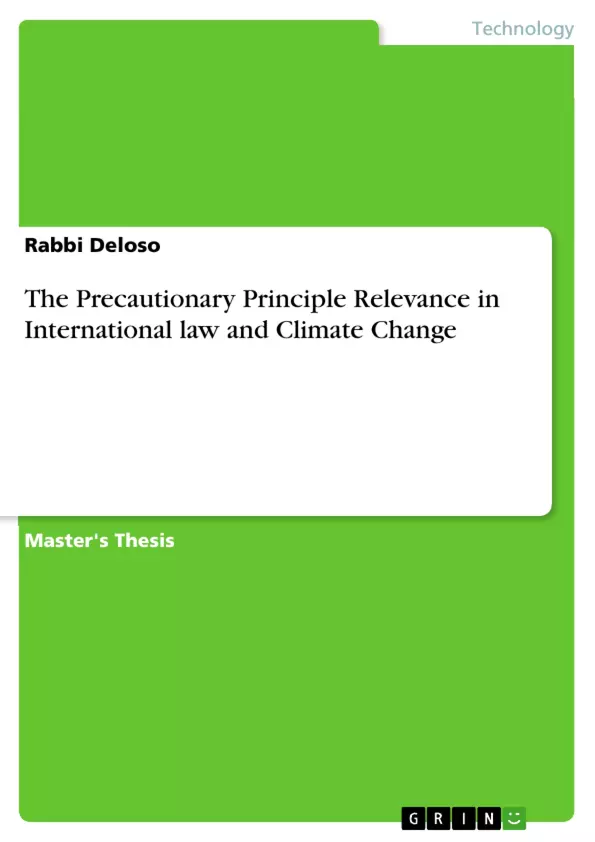The precautionary principle is an old concept with a new character. Threats of harm, since the early days of civilization, were confronted by taking some form of precaution. Throughout history, the concept of precaution provided humans with the moral right to avoid potential harm or damage to his health and his environment despite lack of certainty of its occurrence. Today, the precautionary principle is a common legal concept in national and international regulatory policies. In a nutshell, it means that if there is threat or risk of serious or irreversible damage to human health or the environment, precautionary actions must be taken even though there is lack of full certainty surrounding the issue. This paper looks at the concept of precaution in the framework of international law.
The precautionary principle is particularly applied in the current global effort to address climate change. Despite many uncertainties about the science and impacts of the global warming phenomenon, leaders of the global community, adopted the precautionary principle, instead of the traditional reactive wait-and-see approach, in the climate regime. Although criticized by many for its shortcomings and its marginal position in the practical sense, this paper looks at the legal validity of the precautionary principle based on its sources, rather than its merits. In other words, this thesis looks at the concept of precaution and examines it in the lens of the contemporary international legal system. The first part of this thesis endeavours to understand better the precautionary principle under international conventional law. Influenced by systems approach, this paper particularly analyzed the principle’s relevance with the climate change issue. Guided by the legal positivist approach, the first part argues that the precautionary principle is a significant doctrine in international conventional law. The thesis also examines the precautionary principle in the context of international customary law.
Inhaltsverzeichnis (Table of Contents)
- Abstract
- Chapter 1
- Introduction
- Scope and Research Objectives
- Conceptual Framework, Method and Materials
- Limitations of the Study
- Literature Review
- Chapter 2
- Climate Change: The reality of a warming planet
- Introduction
- The Tragedy of the Global Commons
- The Science of Climate Change
- Historical Development
- Consensus Building
- Consolidation of Expert Knowledge
- The Road to New York
- Establishment of a Global Climate Regime
- Chapter 3
- The Precautionary Principle
- Introduction
- The Origin of the Precautionary Principle
- Historical Development
- The Precautionary Principle under Climate Change Regime
- Different Formulations of Precaution
- Criteria for Precautionary Action
- Issues and Defences
- Analysis of the Definition of Precautionary Principle under International Law
- Standard of Proof
- Chapter 4
- The Precautionary Principle and Climate Change
- Uncertainty factor
- The Precautionary Approach to global warming
- Wait-and-see Approach
- Impacts of Global Warming
- The Role of Global Community
- Chapter 5
- The Precautionary Principle and International Law
- Introduction
- Sources of international Law
- Customary International Law
- Definition and Elements of International Custom
- Analysis of the Precautionary Principle as Custom
- Chapter 6
- Conclusions
- References
- Table of Cases
- Table of Treaties and Declarations
- Other documents
- Interviews/Email Correspondence
Zielsetzung und Themenschwerpunkte (Objectives and Key Themes)
This thesis explores the relevance of the precautionary principle in international law, particularly in the context of climate change. It aims to analyze the legal validity of the principle, examining its sources and its position within the contemporary international legal system. The study delves into the principle's historical development, its different formulations, and its application in addressing the global warming phenomenon. The paper also investigates the interplay between the precautionary principle and international customary law, highlighting its significance within the international legal framework.
- The precautionary principle in international law
- The application of the precautionary principle to climate change
- The legal validity of the precautionary principle
- The role of uncertainty in climate change decision-making
- The interplay between international conventional and customary law
Zusammenfassung der Kapitel (Chapter Summaries)
Chapter 1 introduces the topic of climate change and the precautionary principle, outlining the study's scope, objectives, and methodological approach. It discusses the challenges posed by climate change sceptics and the increasing scientific evidence of anthropogenic influence on the climate system.
Chapter 2 delves into the scientific understanding of climate change, exploring its historical development and the establishment of a global climate regime. It analyzes the "tragedy of the global commons" and discusses the role of human activity in altering the natural climate system.
Chapter 3 focuses on the precautionary principle, examining its origins, historical development, and different formulations. It discusses the criteria for precautionary action, addressing relevant issues and defenses. The chapter also analyzes the principle's definition under international law and the standard of proof associated with it.
Chapter 4 explores the application of the precautionary principle in the context of climate change. It analyzes the role of uncertainty in decision-making, contrasting the precautionary approach with the "wait-and-see" approach. The chapter also discusses the potential impacts of global warming and the role of the global community in addressing this issue.
Chapter 5 delves into the legal framework surrounding the precautionary principle, examining its sources in international law, particularly customary international law. It defines and analyzes the elements of international custom, investigating the applicability of the precautionary principle as customary law.
Schlüsselwörter (Keywords)
The primary keywords and focus topics of this thesis include the precautionary principle, climate change, international law, uncertainty, customary international law, treaties, and global warming. These terms represent the core concepts and research focus of the paper, encompassing the study's central theme of examining the legal validity and relevance of the precautionary principle in the context of climate change and international law.
- Citation du texte
- Rabbi Deloso (Auteur), 2005, The Precautionary Principle Relevance in International law and Climate Change, Munich, GRIN Verlag, https://www.grin.com/document/67440



